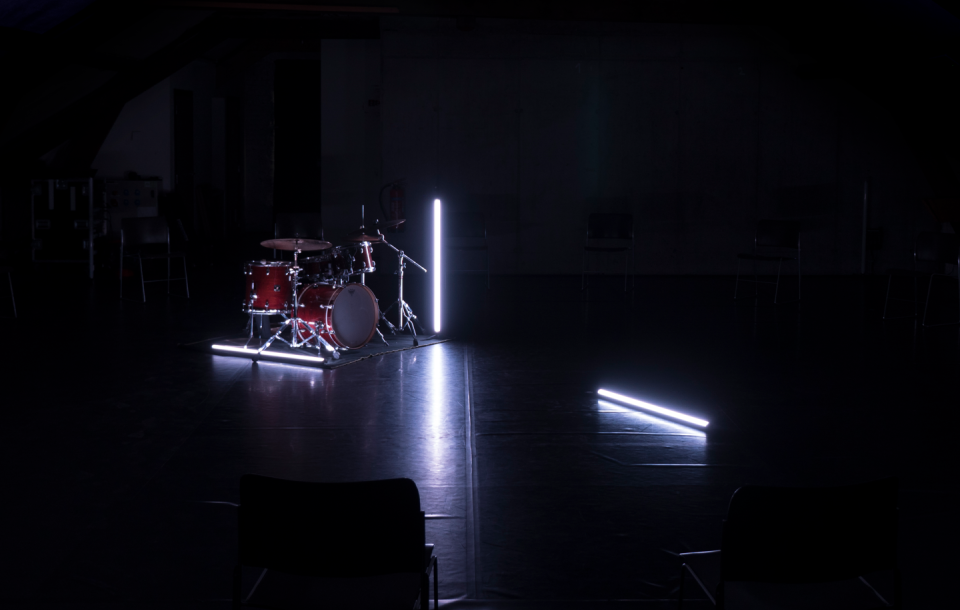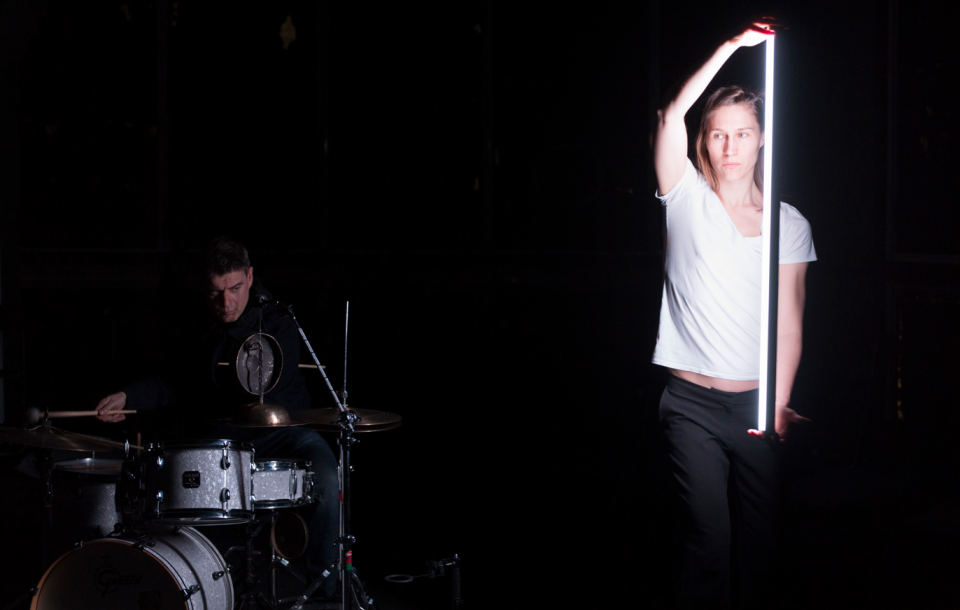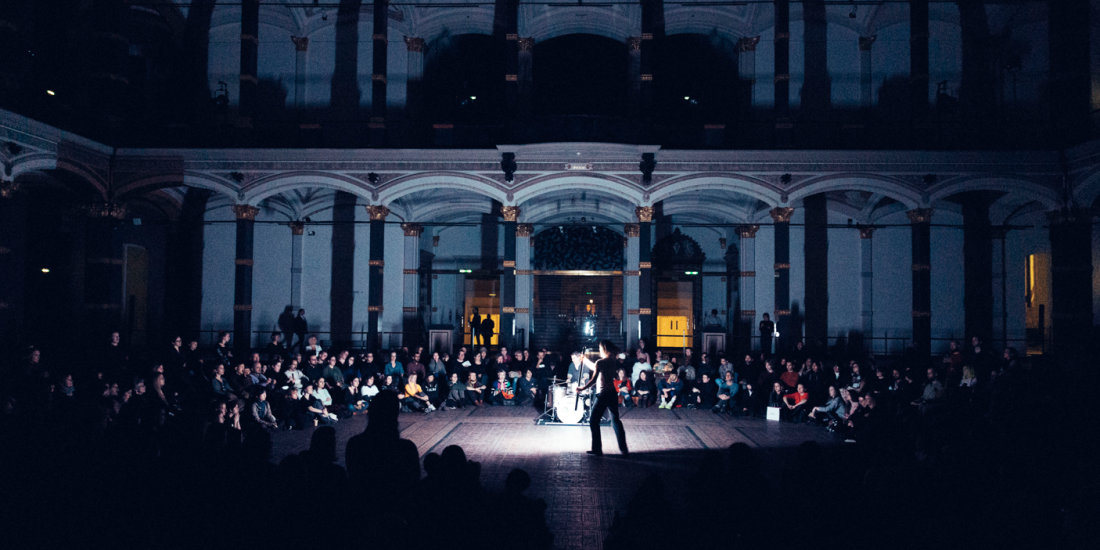All Around brings together your individual disciplines. Could you reflect on how you first met and your shared desire to collaborate?
Mette: Will and I came into contact in 2014 because I wanted to use one of his pieces in a performance I was making at the time. I had listened over and over again to Sticks, Stones, and Breaking Bones and found it to be an absolutely amazing drum solo. Will later told me that he was trying to defy human limits of speed and intensity by imitating the capacities of a machine, which I thought was a great idea. It also related to notions of “incorporated technology” that I became busy with myself in the years that followed. It took us a long time to decide to develop something live together. We shared an interest in working with intensity and minimal transformative structures, and I think that was how our collaboration on All Around in 2019 started.
Will: I had heard of Mette but hadn't seen her work until she reached out to me about using my music. It's crucial for me to have clear and straightforward communication with the person I'm working with. When we met, it became apparent that this would be the case, which is essential for successful collaboration.

What aspects of each other's work caught your attention?
Mette: I was totally blown away the first time I heard Sticks, Stones, and Breaking Bones. I think the way Will is able to maintain energy and speed is very special, and I felt connected to those aspects of his practice. I really like the way rhythms are developed in a progressive and minimal way while being excessive and extremely physical at the same time. The fact that improvisation is a strong part of Will’s practice is something that opened up a different way of working for me. Dealing with live modulations of a common general structure and how to respond to each other in the moment was one of the crucial things that defined our collaboration.
Will: The first piece by Mette I saw was 7 Pleasures. I was very impressed by the idea of mass movement, a giant thriving mass of people becoming one. This type of multidimensional work intrigued me as I found myself taken by the mass dense activity but able to delve into the details of what each person was doing. I have since seen earlier pieces by Mette, like Manual Focus, which I also really enjoyed. I found this piece full of ambiguous images where I wasn’t always sure of what I was seeing. It’s kind of like 7 Pleasures in this regard, but more disturbing and alien from a physical body or movement point of view.
Can you outline the origins of All Around?
Will: We aimed to explore a form that steered clear of direct and literal interactions between sound and movement. Opting for parallel discourses, we focused on two lines - music and dance - that would occasionally converge through direct interactions and other times coexist side by side.
Mette: Yes, and I think we both wanted to explore the idea of abstract intensity. We aimed to work on changes in speed, dynamics, density, and texture of both music and movement. Or more precisely, on highly rhythmic patterns modulated by Will. These patterns would perpetuate my physical movements, based on turning, spinning, and circling around the space. We searched for how to build a high level of intensity that could be sustained for a long time. We thought it better to do it now because, in ten years, we might not be able to work on the limit of our capacities in the same way. We wanted to produce a mesmerizing, almost trancelike state with our minimal and repetitive structures.

How did you harmonize your respective practices?
Will: We talked about how to create a performance that would bridge our two practices, exploring the possibility of inventing a hybrid form between a concert and a performance. The goal wasn't to create music for the dance or vice versa but to establish a collaborative approach that equally engages both disciplines side by side.
Mette: All Around is also a piece that we made in a very short time, which is quite unusual in the performing arts scene but more common in the improvisational music scene. We rehearsed for less than 3 weeks before we showed it the first time, which is unusual for me. But since then, the piece has also grown and changed through performing.
How would you describe the musical and choreographic processes involved in creating All Around? Could you share your insights on this?
Will: As in most collaborative projects, I integrated elements of my existing music into the project with Mette. I had been doing long solo performances of very physically demanding drumming over long stretches, by using only minimal material. Changes in the music arose more from physical failures than deliberate decisions. When talking with Mette, we wanted to keep elements of this intensity in the music for All Around and explore the concepts of repetition and gradual, slow-moving changes.
Mette: Before starting to work with Will, I was already busy working on turning as a practice. For me, it was about emptying the mind to find a flow state that could become ecstatic. I had used a very simple form of turning in another performance in 2017, but had not yet explored longer durations of it. So that was something I was curious about.
The setup of the audience sitting in a circle around me and Will was also crucial to the development of the choreography. The title All Around indicates that the audience is all the way around us, but also that the sound and the light are all the way around them through reflections. The piece is thus based on the idea of envelopment and circularity. Placing the people in a circle around us was a way to include their physical presence in the performance. Almost like a ritual. It allows as many people as possible to be close to the drum kit, the light, and the movement. We hoped that this proximity would create an intensive immersion and bring people with us into the ecstatic or high-intensity states we seek with the piece.

